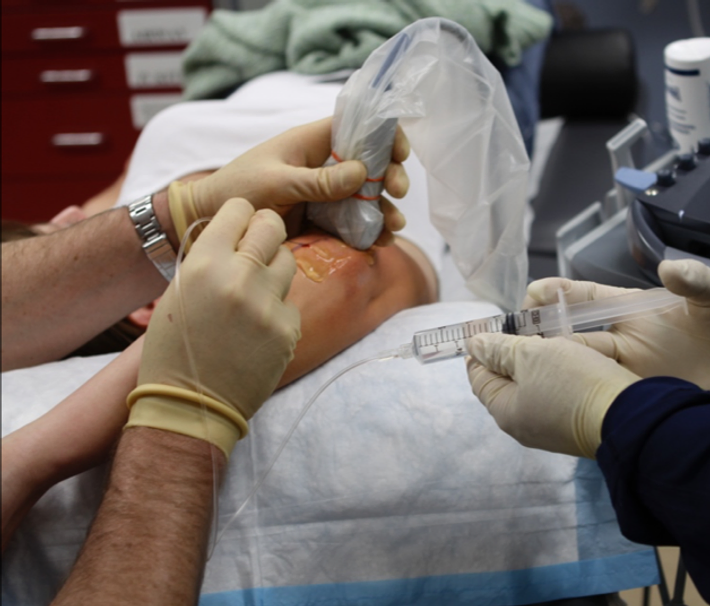Mitigate Pain Clinic – Dr Jeshnu Tople – Pain Management Specialist In Nagpur
Meet Our Doctor

INTERVENTIONAL PAIN AND SPINE SPECIALIST
Dr. Jeshnu Tople
MBBS, DA, DNB, FIAPM, FIPM, FIPP (USA), EDPM (Belgium)
- MBBS from Wardha, Maharashtra
- Diploma in Anaesthesiology from Wardha, Maharashtra
- DNB (Anaesthesiology) from New Delhi
- Fellowship in Pain Management (affiliated to Aesculap Academy, Germany)
- Fellowship of Indian Academy of Pain Medicine from Daradia Pain Hospital, Kolkata
Our Testimonials


Ishan Gadekar

Srujan Topale

Nerve Hydrodissection In Nagpur
Nerve Hydrodissection
If you’re suffering from chronic nerve pain or conditions like sciatica, peripheral neuropathy, or trapped nerves, nerve hydrodissection could offer you a significant improvement. This minimally invasive procedure is gaining popularity in Nagpur as an effective treatment option for people struggling with nerve-related discomfort. Let’s explore what nerve hydrodissection is, its benefits, and how it can help you regain control over your life
What is Nerve Hydrodissection?
Nerve hydrodissection is an innovative technique used to treat nerve pain by gently separating and isolating a nerve from surrounding tissues using a saline solution or other fluids. This procedure aims to reduce pressure or irritation around the nerve, providing immediate pain relief and promoting healing. It’s often performed when nerve entrapment or adhesions cause persistent pain that doesn’t respond to traditional treatments like medication or physical therapy.
Choose Nerve Hydrodissection in Nagpur
Nagpur has a growing number of advanced healthcare facilities that offer nerve hydrodissection, performed by highly skilled specialists. Whether you are dealing with:
- Sciatica
- Carpal Tunnel Syndrome
- Tennis Elbow
- Radiculopathy
- Chronic Neck or Back Pain
How Does Nerve Hydrodissection Work?
The procedure typically involves the following steps:
Diagnosis and Consultation: Before treatment, your doctor will conduct a thorough examination and may order imaging studies like an ultrasound or MRI to pinpoint the source of nerve irritation.
Fluid Injection: Using a needle, the doctor injects a saline or corticosteroid solution around the nerve. This helps separate the nerve from any surrounding structures (such as muscles, tissues, or scar tissue) that might be causing compression.
Relief and Recovery: The goal of hydrodissection is to restore the natural movement and function of the nerve, which often leads to significant pain relief. Many patients feel improvements almost immediately after the procedure, with continued benefits in the following weeks.
Benefits of Nerve Hydrodissection
Non-Surgical: Nerve hydrodissection is a non-invasive procedure, which means it doesn’t require a hospital stay or long recovery times.
Quick Recovery: Most patients can resume normal activities within a few days, with only mild soreness around the injection site.
Effective Pain Relief: By alleviating pressure around the nerve, hydrodissection provides significant pain relief, especially for conditions that involve nerve compression or entrapment.
Minimal Side Effects: Since the procedure is minimally invasive, the risks and side effects are typically very low.
Long-Lasting Results: Many patients experience long-term relief, with the potential for fewer visits or follow-up treatments. Visit Our Hospital.
Nerve Hydrodissection Treatment Options in Nagpur
In Nagpur nerve hydrodissection is offered as an advanced treatment for various types of chronic nerve pain and nerve-related conditions. It is a non-surgical, minimally invasive procedure designed to provide significant relief by separating irritated or compressed nerves from surrounding tissues. Below are some of the key treatments and conditions that nerve hydrodissection addresses in Nagpur:
1. Sciatica Treatment
- What it Treats: Sciatica refers to pain that radiates from the lower back to the legs, often caused by compression of the sciatic nerve.
- How Hydrodissection Helps: By injecting a saline or corticosteroid solution around the affected nerve, hydrodissection helps reduce inflammation and release pressure, providing relief from radiating leg pain and numbness associated with sciatica.
2. Carpal Tunnel Syndrome
- What it Treats: Carpal tunnel syndrome is caused by compression of the median nerve in the wrist, resulting in pain, tingling, and weakness in the hand and fingers.
- How Hydrodissection Helps: Nerve hydrodissection can release the compression around the median nerve, offering significant pain relief and improving hand function without the need for surgery.
3. Radiculopathy (Nerve Root Pain)
- What it Treats: Radiculopathy refers to pain that occurs when a nerve root in the spine is compressed, often leading to pain, numbness, or weakness along the nerve’s path.
- How Hydrodissection Helps: The procedure targets the inflamed nerve roots, reducing irritation and improving mobility by separating the nerve from surrounding tissues and structures that may be causing pressure.
4. Tennis Elbow (Lateral Epicondylitis)
- What it Treats: Tennis elbow is caused by inflammation or irritation of the tendons on the outside of the elbow, often due to repetitive movements.
- How Hydrodissection Helps: By hydrodissociating the surrounding tissues and nerves around the elbow, this procedure can help reduce inflammation and relieve the associated pain, providing a non-invasive alternative to surgery.
5. Chronic Neck and Back Pain
- What it Treats: Chronic pain in the neck or back can result from conditions such as herniated discs, muscle strain, or spinal stenosis.
- How Hydrodissection Helps: In cases where nerve compression is a contributing factor to chronic pain, hydrodissection can provide relief by decompressing the affected nerves and reducing pain and inflammation.
6. Peripheral Neuropathy
- What it Treats: Peripheral neuropathy involves damage to the peripheral nerves, often resulting in pain, tingling, and numbness in the limbs.
- How Hydrodissection Helps: For cases where nerve entrapment or irritation causes neuropathy, hydrodissection can help reduce pain and restore nerve function by easing pressure on the affected nerves.
7. Post-Surgical Scar Tissue (Adhesions)
- What it Treats: Scar tissue or adhesions formed after surgery can cause nerve entrapment and pain.
- How Hydrodissection Helps: The procedure helps to release the nerve from the scar tissue, preventing nerve irritation and reducing pain, promoting recovery and mobility after surgery.
8. Spinal Stenosis
- What it Treats: Spinal stenosis occurs when the spaces in the spine narrow, putting pressure on the spinal cord and nerves, causing pain and discomfort.
- How Hydrodissection Helps: By reducing the inflammation and pressure around the affected spinal nerves, hydrodissection can provide relief from symptoms like pain, numbness, and weakness in the arms or legs..

FAQ's For Nerve Hydrodissection In Nagpur
Nerve hydrodissection is a minimally invasive technique where a fluid is injected around a nerve to separate it from surrounding tissue, which can help relieve pain, reduce inflammation, and improve mobility. It’s typically used to treat conditions involving nerve irritation, compression, or entrapment.
It is commonly used to treat:
- Nerve entrapments (e.g., carpal tunnel syndrome, tarsal tunnel syndrome)
- Chronic pain (especially neuropathic pain)
- Peripheral neuropathies
- Sciatica
- Trigeminal neuralgia
- Entrapped nerves due to scar tissue or inflammation
- Post-surgical pain relief (e.g., following spinal surgery)
- The procedure is performed under local anesthesia, and sometimes sedation is used for patient comfort.
- The doctor identifies the targeted nerve using imaging guidance, such as ultrasound or fluoroscopy.
- A needle is inserted near the nerve, and a fluid (usually saline or a local anesthetic) is injected to separate the nerve from surrounding tissues, helping reduce irritation or pressure.
- The procedure is typically quick, taking 15-30 minutes.
- .
The benefits include:
- Non-surgical treatment option for nerve-related pain.
- Minimal recovery time, with many patients resuming normal activities within a day or two.
- Can provide long-term pain relief and improved function.
- Helps in reducing inflammation and swelling around the nerve.
- Lower risk compared to surgery.
Yes, nerve hydrodissection is generally considered safe when performed by an experienced physician. The procedure carries a low risk of complications, but like any medical procedure, there are potential risks, including:
- Infection at the injection site.
- Nerve injury, though rare.
- Allergic reaction to the fluid used (usually saline or a local anesthetic).
- Temporary increase in pain following the procedure.
The procedure typically causes minimal discomfort. The local anesthetic used to numb the area helps to reduce pain. After the procedure, there might be some soreness or tenderness at the injection site, which usually resolves in a few days.
Pain relief can vary. Some patients feel immediate relief, while others may experience gradual improvement over a few days or weeks as inflammation and irritation decrease. The full benefits may take up to a month to be noticed.
The number of treatments depends on the condition being treated and the patient's response. Some patients may require only one treatment, while others might need several over the course of weeks or months.
Potential side effects are usually mild and temporary, including:
- Swelling, bruising, or redness at the injection site.
- Temporary increased pain or discomfort.
- Numbness or tingling in the treated area.
- Rarely, infection or allergic reactions to the medication used.
Nerve hydrodissection is particularly effective for conditions involving nerve irritation or entrapment. It may not be effective for all types of nerve pain, such as those caused by systemic diseases (e.g., diabetes-induced neuropathy). Your doctor can help determine if it's the right treatment for your condition.
Our Treatments
- Joint Pain
- Back Pain
- Sciatica Pain
- Neck Pain
- Hand Pain
- Shoulder Pain
- Foot & Ankle Pain
- Limb Pain
- CRPS Pain
- Cancer Pain
- Headache
- Hyperhidrosis
- Herpes Zoster Pain
- Chronic Pelvic Pain
- Scar Tenderness
- Postherpetic Neuralgia
- Trigeminal Neuralgia
- Peripheral Neuralgia
- Chronic Vascular Pain
- Generalised Body Pain
- Chronic Injury Pain
- Failed Back Surgery Syndrome
- Chronic Post Surgical Pain
- Other Painful Conditions
- Slipped DISC / PIVD